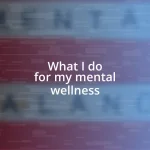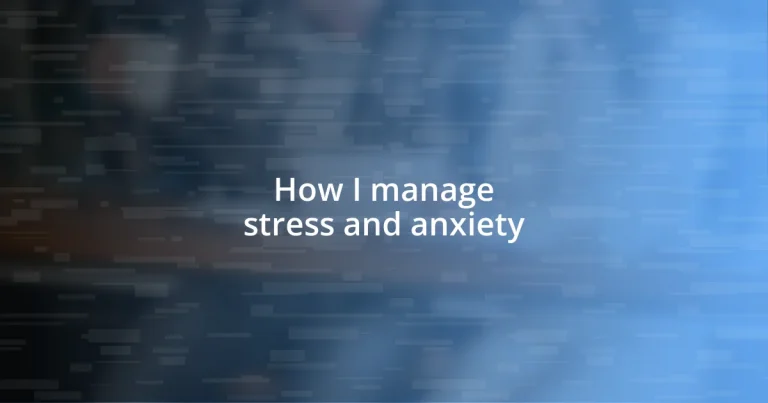Key takeaways:
- Understanding triggers for stress and anxiety is crucial for effective management, such as identifying specific situations that heighten feelings—like public speaking or chaotic environments.
- Incorporating coping strategies like deep breathing, mindfulness, and physical activities (e.g., yoga, hiking) helps alleviate immediate stress and promotes emotional well-being.
- Building a supportive social network and maintaining long-term practices like journaling and structured routines enhance resilience against stress and foster better mental health.

Understanding stress and anxiety
Stress and anxiety are often misunderstood, but I see them as part of our natural response system. When I face a tight deadline, for instance, my heart races, and I feel a surge of adrenaline. It’s like my body is gearing up for action—but there’s a fine line between helpful stress and overwhelming anxiety. Have you ever felt that rush transform into a heavy weight on your chest? It can be daunting.
I remember a time when I first encountered constant anxiety, particularly during the pandemic. It felt like I was in a fog, unable to focus even on the simplest tasks. That experience taught me how anxiety can manifest in our lives, often without warning. Do you find that certain situations trigger your anxiety more than others? For me, it’s social gatherings; I often questioned why I felt this way. Understanding those triggers has been crucial for managing my emotions.
Recognizing that stress and anxiety can sometimes lead to physical symptoms has been eye-opening as well. My shoulders often tense up, and I notice this tightness creeping in when I haven’t taken a break. It’s fascinating how our minds can affect our bodies, isn’t it? Learning to listen to these signals has made a significant difference in how I tackle challenging situations.

Identifying personal stress triggers
Identifying personal stress triggers is an essential step in managing stress effectively. I often reflect on the moments when I feel overwhelmed—like the time I panicked before giving a presentation. It became clear to me that the imminent pressure of being in front of an audience heightened my anxiety. By pinpointing that specific situation, I could work on techniques to alleviate that stress instead of letting it consume me.
A simplistic exercise has really helped me: keeping a stress journal. I jot down the circumstances that lead to heightened stress levels along with my feelings during those instances. For example, I realized that late-night work sessions made my anxiety spike, making my mornings feel dreadfully heavy. Understanding these patterns has allowed me to set boundaries, such as avoiding late work hours. Have you ever thought about what situations consistently trigger stress in your life?
Finally, I’ve noticed how certain environments play a big role in my stress levels. The chaotic atmosphere of my local café, buzzing with chatter, often adds to my anxiety rather than helping me focus. Conversely, when I work in a quieter space, my mind feels at ease and more productive. Recognizing these contrasting atmospheres is vital; it’s about finding where I thrive and where I falter.
| Trigger | Response |
|---|---|
| Public speaking | Increased anxiety, heart racing |
| Late-night work | Heightened stress, difficulty sleeping |
| Chaotic environments | Feeling overwhelmed, unable to concentrate |
| Quiet spaces | Calmness, increased productivity |
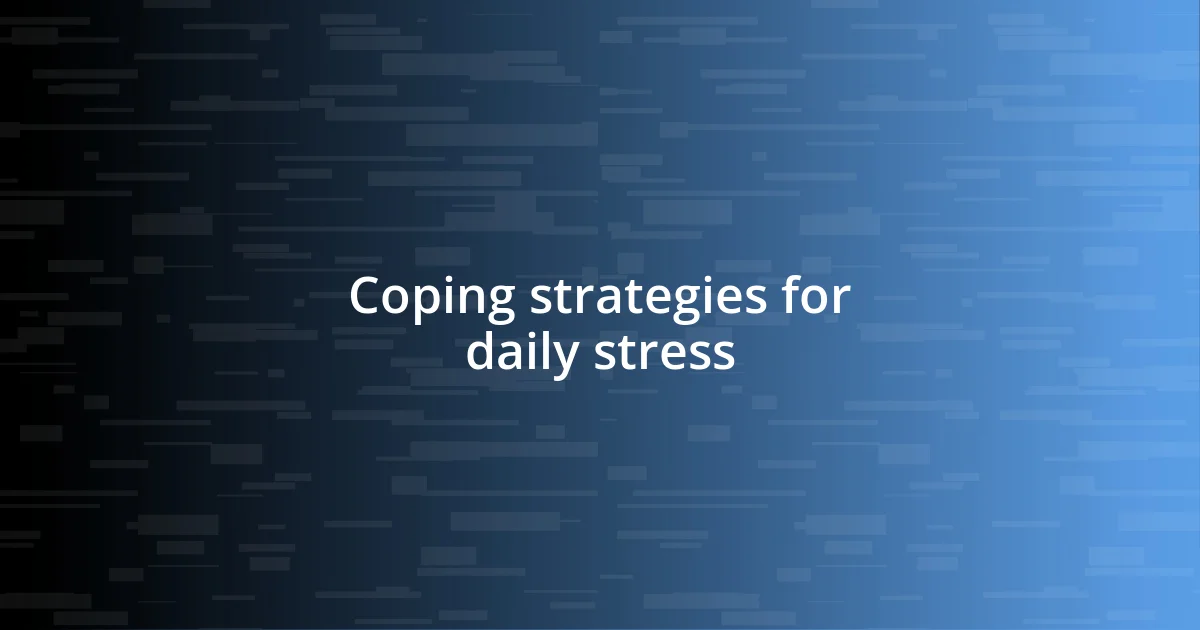
Coping strategies for daily stress
When it comes to daily stress, I’ve found that building a toolkit of coping strategies makes all the difference. One tactic that really puts my mind at ease is deep breathing exercises. I often picture myself inhaling calmness and exhaling tension, which can shift my state of mind in just a few moments. I remember a particularly hectic day at work; stepping outside for a few deep breaths transformed my outlook and brought me back to focus.
In addition to breathwork, I’ve embraced small moments of joy throughout my day. For instance, taking a few minutes to listen to my favorite song while brewing coffee lifts my spirits immensely. Here are some practical strategies I incorporate regularly:
- Mindful breathing: Focus on your breath for a few minutes to center yourself.
- Gratitude journaling: Write down three things you’re grateful for each day to shift focus.
- Short walks: A quick stroll, even if it’s just around the block, helps clear my mind.
- Stretching: I’ve found that simple stretches can release physical tension accumulated during the day.
Creating routines that prioritize these strategies has made my days more manageable. Whenever I sense stress creeping in, having these tools at hand is invaluable—it’s like my personal lifeline.
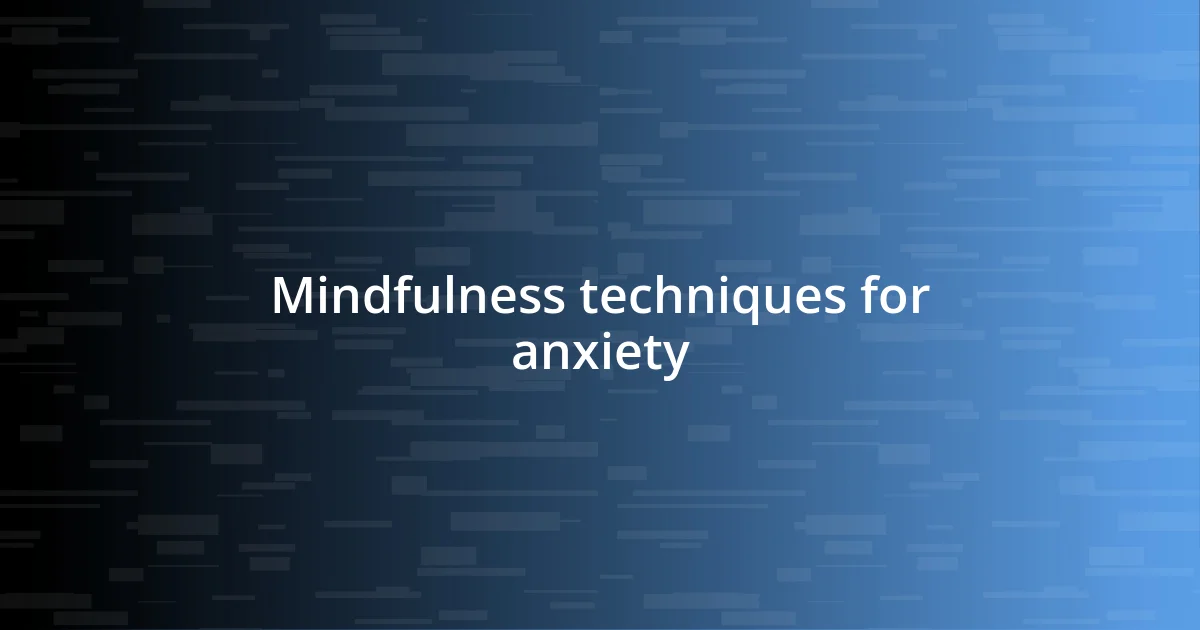
Mindfulness techniques for anxiety
Mindfulness techniques have become a cornerstone in my approach to managing anxiety. One technique that has truly resonated with me is the practice of mindful observation. I remember one afternoon, sitting in my garden, I focused solely on the colors of the flowers and the sound of the rustling leaves. It felt like my mind momentarily hit a pause button, allowing me to escape from swirling thoughts. Have you ever taken a moment to simply observe your surroundings? That intentional shift in focus can be incredibly grounding.
Another powerful method I’ve incorporated is guided imagery. Before a stressful event, like a job interview, I vividly imagine myself in a peaceful location, like a serene beach with waves gently lapping at the shore. This visualization not only calms my racing heart but also sets a positive tone for the upcoming challenge. Sometimes, I wonder how often we forget to harness the power of our imagination. It’s fascinating to realize how a simple technique can create such a profound sense of peace.
Lastly, I’ve found that combining mindfulness with movement, such as yoga, truly enhances my emotional well-being. During a particularly challenging week, I decided to attend a local yoga class. As I flowed through the poses, I felt tension melting away with each exhale. The connection between my breath and movement helped anchor me, reminding me that I have the ability to navigate life’s ups and downs with grace. Have you ever noticed how physical activity can shift your mindset? It definitely makes a difference for me!
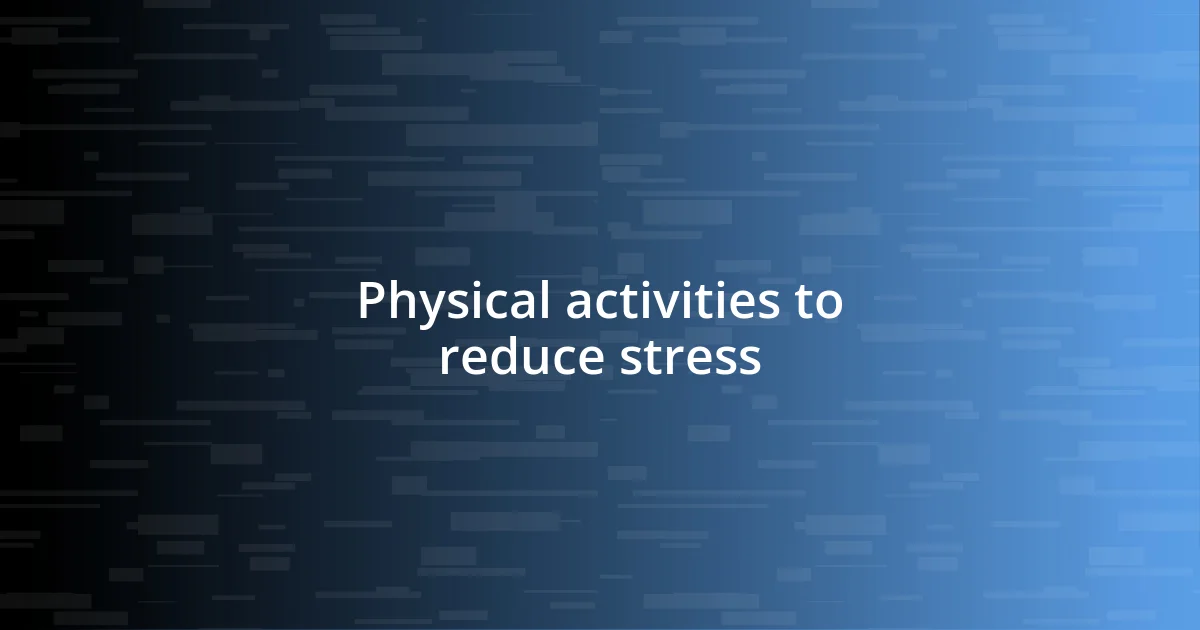
Physical activities to reduce stress
Engaging in physical activities has been a game-changer in how I manage stress and anxiety. Every time I lace up my sneakers for a run, I can feel my worries start to fade with each step. It’s almost as if the rhythm of my feet hitting the pavement synchronizes with my heartbeat. Have you ever experienced that rush of endorphins after a workout? It’s an exhilarating reminder that even on tough days, I have the power to lift my mood.
I’ve also found that joining a dance class not only gets me moving but tunes me into pure joy. There’s something liberating about letting loose to music and forgetting the stresses of the day. One particular class I attended felt transformative; as I twirled and swayed, I could feel my anxious thoughts melt away, replaced by a sense of freedom. When was the last time you danced like nobody was watching? I often find that embracing movement in such a playful way can really recharge my emotional batteries.
Moreover, hiking has become one of my favorite ways to connect with nature and unwind. I recall a breezy Saturday when I hit the trails with a friend. The beauty of the lush greenery and the gentle sounds of the stream nearby enveloped me in tranquility. That day, as we climbed higher, I felt the weight of my thoughts lighten. It’s incredible how nature combined with physical activity can create a potent antidote to stress. When was the last time you stepped outside for an adventure? I genuinely believe that simply being active outdoors can do wonders for our state of mind.

Building a supportive social network
Building a supportive social network has been crucial for my stress management. I still remember during a particularly overwhelming period when I reached out to a close friend, sharing my fears and anxieties. That heartfelt conversation not only lifted a weight off my shoulders but also reminded me how vital it is to have someone willing to listen. Have you ever experienced the relief of simply talking things out?
Creating connections isn’t just about having people around; it’s about surrounding myself with those who uplift and inspire me. I intentionally seek relationships with positive influences, whether it’s through community groups or online forums focused on mental wellness. Last month, I joined a local book club, and the discussions have become a source of joy and support. It’s a reminder that the right companions can create an atmosphere where vulnerability feels safe. When was the last time you connected with someone who truly understood what you were going through?
I’ve also discovered the immense power of shared experiences. Organizing monthly coffee dates with friends has been a delightful way to unwind and bond. I always look forward to hearing their stories and sharing my own, which helps me feel less isolated in my struggles. Sometimes, the mere act of being present with others transforms a mundane day into something special. Have you ever noticed how laughter shared in good company can instantly lighten your mood? It’s those moments of connection that truly enrich our lives.
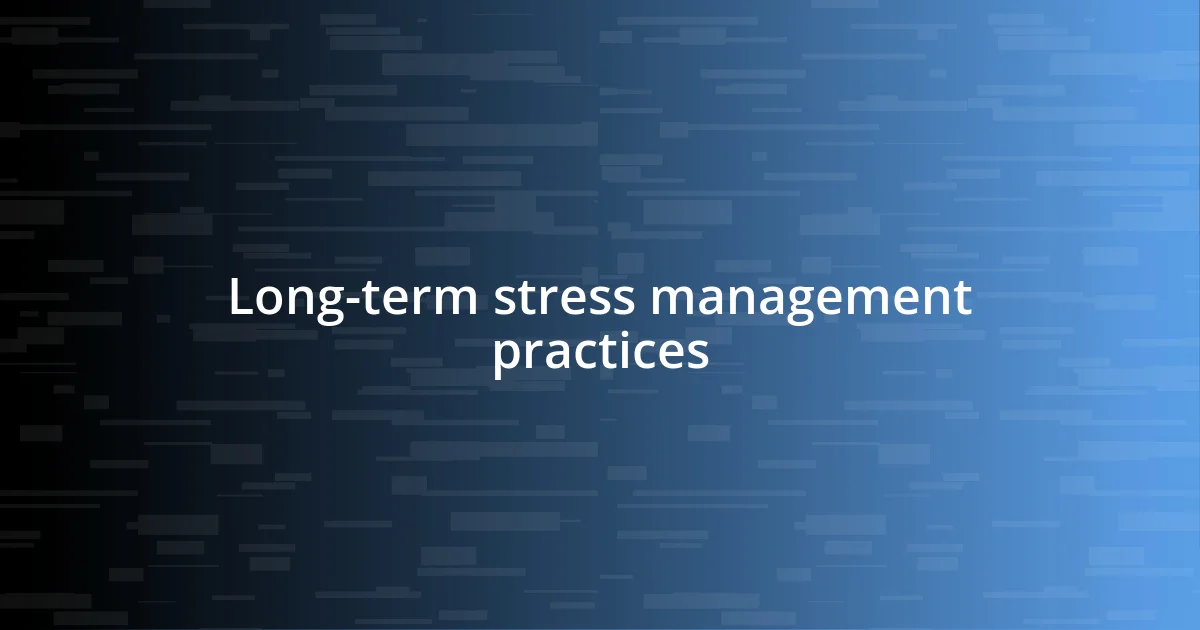
Long-term stress management practices
Adopting mindfulness practices has been a significant part of my long-term strategy for managing stress and anxiety. I vividly remember the first time I tried meditation; it felt strange to sit quietly with my thoughts. However, as I embraced the practice, I discovered a deeper awareness of my emotions. Have you ever stopped to notice how your breath can anchor you in the present moment? I’ve learned that just a few minutes of focused breathing can clear my mind and make overwhelming situations feel more manageable.
Another vital aspect I’ve integrated is establishing a consistent routine. I used to wander through my days without any structure, and it often left me feeling anxious about what was next. By setting a daily schedule that includes time for self-care, work, and relaxation, I found a rhythm that enhances my productivity and peace of mind. When I see a prioritized list of tasks, it gives me clarity. Have you noticed how a little organization can reduce feelings of chaos?
Additionally, I’ve embraced journaling, which has been therapeutic in processing my thoughts. I remember days when anxiety felt suffocating, and putting pen to paper became a lifeline. As I write, I can untangle my feelings and reflect on my experiences, gaining insight into my triggers. It’s fascinating how externalizing thoughts can shift my perspective. Have you tried journaling as a way to navigate through your emotions? Each page serves as a quiet conversation with myself, and the freedom to express my worries ultimately lifts that heavy weight off my chest.





